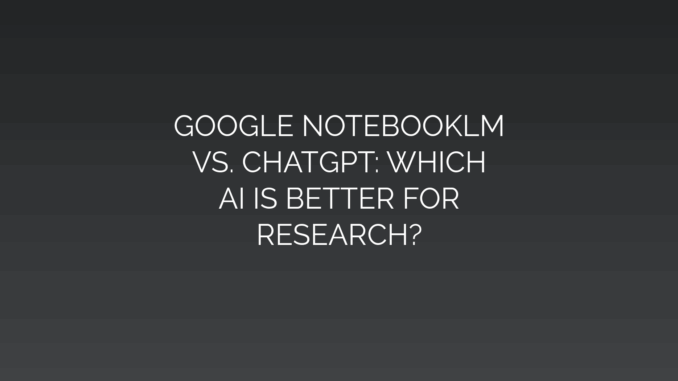
Google NotebookLM vs. ChatGPT: Which AI Is Better for Research?
The integration of artificial intelligence into academic and professional research workflows is transforming how we analyze information. Two prominent tools—Google NotebookLM and OpenAI’s ChatGPT—stand out for their ability to streamline research processes. While both leverage large language models, they target different user needs and workflows. This article dissects their strengths, limitations, and ideal use cases to help you determine which AI partner best aligns with your research goals.
Overview of Google NotebookLM
Google NotebookLM, currently in experimental stages, is a specialized AI designed exclusively for synthesizing personal data. Unlike generic chatbots, it operates as a “virtual research assistant” that grounds responses strictly in useruploaded source materials like PDFs, Google Docs, and text files.
Key Features:
- Source-Grounded Reasoning: Generates responses solely based on uploaded documents, minimizing hallucinations.
- Dynamic Citations: Automatically links every claim to specific source passages for verification.
- Multi-Document Synthesis: Cross-references insights across up to 100+ files simultaneously.
- Automatic Summarization: Creates FAQs, summaries, and outlines tailored to your corpus.
- Free Access: Currently available at no cost, prioritizing privacy with unreviewed data.
NotebookLM excels in closedsystem research, where accuracy and source traceability are paramount.
Overview of ChatGPT
ChatGPT, powered by OpenAI’s GPT3.5 or GPT4 (for paid users), is a versatile, conversational AI trained on a massive public dataset. It supports broad knowledge tasks, from creative writing to technical problemsolving. Its Advanced Data Analysis (formerly Code Interpreter) and web browsing capabilities further enhance research applications.
Key Features:
- Broad Knowledge Base: Draws from extensive pre-trained data updated until late 2023 (GPT-4).
- Multifunctional Skills: Handles coding, data visualization, content drafting, and more.
- Web Browsing (Pro Feature): Retrieves real-time information from the internet.
- Plugin/API Ecosystem: Connects with tools like Zotero, Wolfram, and scholarly databases.
- Cross-Platform Flexibility: Available via web, mobile apps, and third-party integrations.
ChatGPT’s strength lies in openended exploration and idea generation beyond userprovided materials.
Comparative Analysis: 5 Key Research Metrics
1. Handling Source Material NotebookLM:
- Mandates document uploads to generate insights.
- Dynamically cites sources, enabling academic-grade reference tracking.
- Ideal for literature reviews or proprietary data analysis.
ChatGPT:
- Can process uploaded files (PDFs, spreadsheets) but may conflate source content with pre-trained data.
- Provides citations only when explicitly requested (with variable reliability).
- Best suited for brainstorming or conceptual work unconstrained by specific texts.
Verdict: NotebookLM wins for sourcecentric, citationdriven research.
2. Accuracy and Hallucination Control NotebookLM:
- Hard-caps responses to user documents, drastically reducing unsupported claims.
- Limitations include potential source bias and lack of external context.
ChatGPT:
- Generates fluent, expansive responses but risks hallucinations if queries exceed pre-trained knowledge.
- GPT-4 improves reliability but still requires manual fact-checking.
Verdict: NotebookLM offers superior factual fidelity; ChatGPT requires careful verification.
3. Depth of Critical Analysis NotebookLM:
- Excels at comparative analysis, argument extraction, and identifying contradictions across uploaded sources.
- Weak at integrating broader domain knowledge.
ChatGPT:
- Leverages vast external knowledge to contextualize concepts, debate theories, or explore interdisciplinary angles.
- Generates outlines, hypotheses, and counterarguments fluidly.
Verdict: ChatGPT leads in contextual depth; NotebookLM dominates in corpusspecific critique.
4. Workflow Integration NotebookLM:
- Streamlined editor for notes, sources, and AI outputs.
- Integrates natively with Google Drive.
- Lacks third-party extensions or API.
ChatGPT:
- Supports plugins (e.g., ScholarAI, Scite) for direct literature reviews or data visualization.
- API enables automation with academic tools like Python or reference managers.
Verdict: ChatGPT offers superior flexibility for complex, multitool workflows.
5. Accessibility and Cost NotebookLM:
- Free during its experimental phase.
- Available only in the U.S. via limited-access waitlist.
ChatGPT:
- Free tier (GPT-3.5) with export restrictions.
- ChatGPT Plus ($20/month) unlocks GPT-4, web browsing, plugins, and file uploads.
Verdict: NotebookLM is ideal for budgetconscious researchers but accessrestricted. ChatGPT’s free tier is globally accessible, while Plus unlocks premium functionality.
Which Tool Should Researchers Choose?
Use Google NotebookLM If:
- You prioritize accuracy and verifiability for proprietary datasets or sensitive materials.
- Your workflow involves dissecting complex documents (e.g., technical manuals or dense academic papers).
- You need automatic citations and source-driven synthesis without external noise.
Use ChatGPT If:
- You require wider contextual knowledge beyond owned documents (e.g., hypothesis generation or interdisciplinary research).
- Your work involves coding, data analysis, or integrations with existing tools via API/plugins.
- Real-time information (via web browsing) or multi-format content creation is critical.
The Future of AI-Powered Research
Neither tool is universally superior—their efficacy depends on research scope. For evidenceintensive tasks, NotebookLM’s documentcentric approach offers unmatched precision. For exploratory or creative research, ChatGPT’s broad knowledge and integrations accelerate innovation. As both evolve—NotebookLM toward expanded access/tooling, ChatGPT through specialized plugins—researchers stand to gain from combining these AI allies strategically.
Pro Tip: Pair both tools: Use NotebookLM to distill core insights from primary sources, then feed findings into ChatGPT for contextual expansion or presentation drafting. This hybrid approach balances rigor with creativity.
Navigate your next project with clarity: let datadriven needs dictate whether the grounded precision of Google NotebookLM or the expansive ingenuity of ChatGPT merits a place in your scholarly arsenal.
Leave a Reply